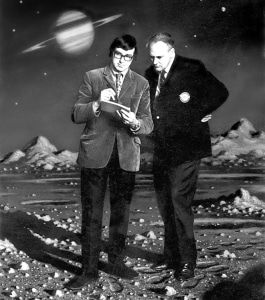Sir Patrick Moore, 1923–2012 (obituary).
an obituary by David A. Hardy
A supergiant that has shone brightly in the sky at night for so many years has finally been extinguished, leaving a vacuum which will be very difficult to fill. On 9th December 2012, Sir Patrick Moore (Patrick Alfred Caldwell-Moore) died peacefully at his home in Selsey, Sussex, after being in poor health for several years. He was single-handedly responsible for sparking an interest in astronomy and space in thousands of people, many of whom became professionals in the fields of astronomy and science. He was always generous in sharing his enthusiasm with others and replied to all letters. He insisted that he was purely an amateur astronomer and he had no degrees, apart from several honorary doctorates. He was awarded an OBE in 1968, a CBE in 1989 and was knighted in 2001.
I can speak personally because I had known and especially worked with Patrick for longer than just about anyone else. The first book I illustrated was his ‘Suns, Myths And Men’ in 1954 when I was 18, launching my own career as an astronomical and SF artist, illustrator and writer that lasts into the present day (see www.astroart.org). In 1957, I was his first artist on ‘The Sky At Night’ and continued to be so for many years. I also appeared several times as a guest on the programme, talking about space art, the IAAA and depictions of Mars.
‘The Sky At Night’ went out every month without a break and he presented all but one, in 2004 when he got food poisoning as a result of what he called ‘a dodgy duck egg’. Patrick presented the image of an eccentric, with his baggy suit, RAF tie askew, wild hair and shaggy eyebrows holding precariously onto his trademark monocle, but this image shielded a razor-sharp mind with a memory like a computer. Just name any astronomical object and he could trot out all of its relevant details: size, distance from the Sun or Earth, rotation period, whatever…
In recent years, with the advent of digital technology, some of his homemade demonstrations, featuring cricket balls, pencils, electric light bulbs and such became rather a joke but they got his message across and were probably more memorable because of it. He was, of course, also a musician and had perfect pitch, playing piano and xylophone and composing a number of pieces. He hated rock music, making his close friendship with Queen guitarist Brian May seem more surprising, but they were very close until the end. They also shared a passion for stopping cruelty to animals, such as fox hunting and the badger cull. Patrick was also a keen cricketer.
Patrick had an interesting relationship with UFOs. It was in fact an appearance on a discussion programme about these that led to his first ‘Sky At Night’. While claiming to have an open mind, he actually regarded people who believed in flying saucers as cranks and kept a file of the letters he received. Having replied politely, saying that this was ‘somewhat outside his field’, a few weeks later the sender would receive a letter from ‘L.F.Antyne’ or ‘R.T. Fischall’ in Tunbridge Wells or elsewhere, drawing them out on their beliefs or experiences! I well remember taking photographs of a model ‘Adamski’ saucer hanging by a thread from one of the apple trees in his garden, with Patrick pointing melodramatically at it. Politically, his views were sometimes controversial, especially on the subject of immigration (and don’t mention the Germans!). In the 1980s, he briefly formed his own political party, the United Country Party; he once told me, ‘I’m thinking of starting the Politically Incorrect School of Sociology – and the acronym says it all.’ He served as a navigator in the RAF during the War, having lied about his age and somehow falsified his medical report and became engaged to his only sweetheart, Lorna, who was killed while driving an ambulance during the Blitz. After this, he says, he never looked at another woman.
He wrote Science Fiction, though at a juvenile level, and I painted covers for a number of these, such as ‘Caves Of The Moon’ and ‘Planet Of Fear’. Actually, although ‘of their time’, many of these stories are pretty good as Patrick did not lack imagination. He always claimed not to be able to draw or paint himself, yet he produced many accurate maps of the Moon, which astronauts like Armstrong and Aldrin, both of whom he met, acknowledge as being helpful when planning lunar landing sites. He met Yuri Gagarin, the first man in space and also claims that when he was an RAF recruit he met and chatted to Orville Wright, a remarkable and possibly unique record. But then, Patrick led an extraordinary life and his legacy will live on long after him.
I sincerely hope that the BBC will continue to broadcast ‘The Sky At Night’, perhaps with its current team of younger astronomers, as it is the ONLY regular astronomy programme on TV in this country and quite possibly anywhere. But it will surely be impossible to find another main presenter with the knowledge, enthusiasm, presence and charisma of Patrick Moore at his best.
© David A. Hardy 2012






